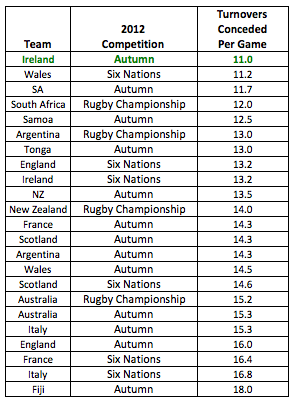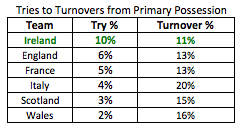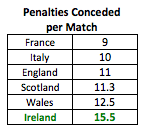Ireland Six Nations Preview – O’Mahony vs. Henry
Declan Kidney made a big choice in going for Peter O’Mahony over Chris Henry for Saturday’s match against Wales. Before looking at that specifically, let’s look at a couple of other factors from Ireland’s general play in the Autumn Internationals.
Irish Efficiency
During Ireland’s short Autumn series they proved exceptionally good at not turning over the ball during play. With an average of 11 turnovers per game they recorded the lowest mark by any team who played in 2012’s Autumn Internationals, the Rugby Championship or the Six Nations; the nearest being the 11.2 per game conceded by Wales in their grand slam winning campaign last spring.
This good work was reflected in Ireland’s try to turnover rate which was hugely efficient*.
From primary possession Ireland managed to record the best mark by a Six Nations team in not just one but both measures, resulting in an excellent 1:1 ratio. It compares very well to any other mark, the nearest being England who are just outside the 1:2 range.
* Because Ireland played just two full test matches with one of those being a seven-try romp against Argentina, this comes with a sample size health warning. On the other hand, Ireland didn’t get to call their game against Fiji a test match due to the IRFU’s contractual obligations to Aviva. So we’ll let it ride.
Indiscipline
Unfortunately this discipline in one aspect of the game was returned with interest in the extravagantly generous number of penalties given away by Ireland, a full 15.5 per match. Nor was this a matter of getting on the wrong side of a referee in one particular game; against South Africa Ireland conceded 15 while against Argentina Ireland conceded 16. Admirable consistency, if mis-applied.
Irish Open-Sides
With all of the above in mind it’s interesting to note some key differences between Chris Henry and Peter O’Mahony, Declan Kidney’s two primary open-side options for the Six Nations.
Henry and O’Mahony played 160 minutes and 142 minutes respectively in the two Autumn tests. Defensively, they were of a similar order with Henry’s 100% tackle rate (13/0) balanced by O’Mahony’s two forced turnovers in the tackle while maintaining an acceptable 88% rate (15/2).
O’Mahony’s good work in the tackle area, however, was undone in a major way by his lack of discipline elsewhere on the park. In conceding six penalties, third most by a Six Nations player in the Autumn tests, O’Mahony was penalised twice as often as Henry while spending less time on the pitch. For good measure, O’Mahony also conceded three turnovers to Henry’s nice round zero.
With ball in hand, Henry again shone brighter than his Munster rival; both had 16 carries but Henry made twice as many yards from those carries, 40 to 21.
Ireland used O’Mahony as their primary target in the middle of the lineout which was without doubt a factor in Kidney’s decision-making. Henry wasn’t entirely absent from the aerial battle; he was Ireland’s key man from restarts taking six of them while nobody else took even two. It’s important to note that these two elements, lineout targeting and restart collection, have a very high dependency on systems and gameplans on a given day. In that regard they cannot be viewed in isolation; they are included simply to illustrate that whichever of these two players lost out they would leave work that will have to be passed on to somebody else on Saturday. Rugby is like that. Is that lineout role enough to overlook the many other areas in which O’Mahony was outshone by Henry? It’s certainly worth asking the question.
Return of the King
As mentioned, one of O’Mahony’s positives was his forcing two turnovers in the tackle area. During the Autumn series, compared to the other Six Nations sides Ireland were actually below average where forcing such turnovers was concerned, averaging three per match. For the last decade Ireland have been extremely fortunate in having two centres, Gordon D’arcy and Brian O’Driscoll, who have played the role of auxiliary open-sides turning over countless ball in the tackle area. More recently they have been joined by Jonathan Sexton who shows consistent excellence in both making hits and standing people up.
With this in mind it was notable that Ireland were alone among the Six Nations teams playing last Autumn in that not one of their turnovers in the tackle was forced by a back. That was in a side without Brian O’Driscoll, famed for his prowess in the tackle area. O’Driscoll’s return and his ability at the breakdown could well have gone some way to allowing Kidney to choose O’Mahony over a more pure open-side in Henry, judging that O’Driscoll would be picking up some of the slack.
The Autumn Internationals data used in this article was supplied by the good people of Opta.
The above piece was published as part of the Balls.ie Rugby Nerds Mega Six Nations Preview





Am I incorrect in understanding “Forced Tackle Turnovers” to indicate turnovers *won* by the players?
Correct. O’Mahony won two turnovers in the tackle – in the piece I view this as being balanced by his missing of two other tackles as opposed to Henry’s zero missed tackles. Hope that’s clear :-)
Well so then this is the conclusion I find interesting:-
“O’Driscoll’s return and his ability at the breakdown could well have gone some way to allowing Kidney to choose O’Mahony over a more pure open-side in Henry, judging that O’Driscoll would be picking up some of the slack.”
If O’Driscoll does some on the deck stuff (that is the one area in your table where O’Mahony produced something Henry didn’t), then surely O’Driscoll’s inclusion would allow him to think a little more about Henry?
I understand the point you’re making, and if one were looking at forced turnovers in isolation you’d be absolutely correct.
But it’s not quite that simple.
O’Mahony might have indeed forced two turnovers but he *lost* even more:
a) lost the ball in a ruck/maul
b) got pinged for not rolling away
c) got pinged for handling in the ruck
That’s not even going into the other seven turnovers and penalties which O’Mahony gave away.
Thanks for putting up the question though – definitely worth asking and I hope I’ve clarified it for you.
I suppose my focus on forced turnovers is probably drawn from the idea that that is most of what Drico brings to the open-side table
Anyway, interesting reading, on all fronts. Keep’em coming!
Very interesting piece Andy.
For me a direct comparison between two players in the one team playing in different positions is a little unfair. O Mahony as blind side and line out jumper is nearly always going to have less carries and tackles then an open side who doesn’t feature in the line out. Remember when teams are attacking they attack the open side pitch more often giving Henry a decent advantage in carrying (offensively) and tackling (defensively)
The penalty account is interesting, you would probably have to review each penalty to see if they were necessary because O Mahony is the go too man for Munster to give away penalties when needed so maybe performs the role for Ireland too.
For me Irelands performances against South Africa and Argentina were two of the best back row performances we have had in recent times and I think Henry is very unlucky and personally I would have gone for him ahead of O Brien as opposed to O Mahony.
I am sure you are a busy man but I wonder how other sixes and sevens compare in other teams. Hint hint.
@Tommy… *jots down 6/7 comparison note* :)
May I ask what is the one point you be comparing? Really top work Andy very few “statistical” pieces in the papers on rugby. Strange given how prominent they are within the game its self.
I’m pretty sure it was 3 turnovers to O’Mahony and 1 to Henry. I watched the games back recently.
Some other small sample size caveats: Henry received straight from the kick-off 5 times, running an average of say 4 metres, which accounts for half of his metreage.
I’m doubtful as to the worth of the lost turnover measure attributed to one player, as it is more frequently caused by a lack of organisation of the clearout for forwards, or for backs, by good pressure defence. Your reply above seems to indicate you think otherwise.
There was one turnover by backs in the course of the 2 games. D’Arcy and Earls forced one against Argentina prior to the melee in which the Argentinian prop was sin-binned.
O’Mahony’s penalties were for 2 line-out offences, 3 ruck penalties, and 1 block at kick-off time. 1 was 50/50 between a turnover and a penalty, with Peyper stamping his authority early. It was one of two penalties in the early minutes of the Argentina game, which resulted in Ireland competing less vigorously at the breakdown thereafter. Hence the low breakdown turnover stats in that match.
The H Cup stats for the two players are quite different, by the way. Henry conceded 2 more penalties and made 150 fewer metres, but made 50 more tackles. Another interesting stat was O’Mahony’s 15 defenders beaten, as compared with Henry’s 0. Turnovers won were unfortunately not recorded by ESPN.
@HenryFitz Agreed on sample size. Four games (for an England or a Wales) is bad enough but two is tough. The stats above are those recorded by Opta for the Autumn Internationals, to which I was given access.
Delighted to get a comment that was so well thought out. The difference in usage of a particular player for different teams (e.g. club vs. country) is one comparison I’ve got on my list of “things to examine”.
Your comparison would be terrific if you were making a comparison for the same position but POM was picked as a 6, not at 7. A more relevant comparison would have been with Sean O’Brien
@RichardP Thanks for reading. The returning O’Brien wasn’t certain to be picked at 7. Realistically, the decision was always going to be Heaslip, O’Brien and one of O’Mahony (6) and Henry (7) with O’Brien shifted to open or blind respectively depending on who Kidney chose to partner him. In that light, I considered a comparison between O’Mahony and Henry to be of interest. I hope you still found some elements of the piece interesting. :)